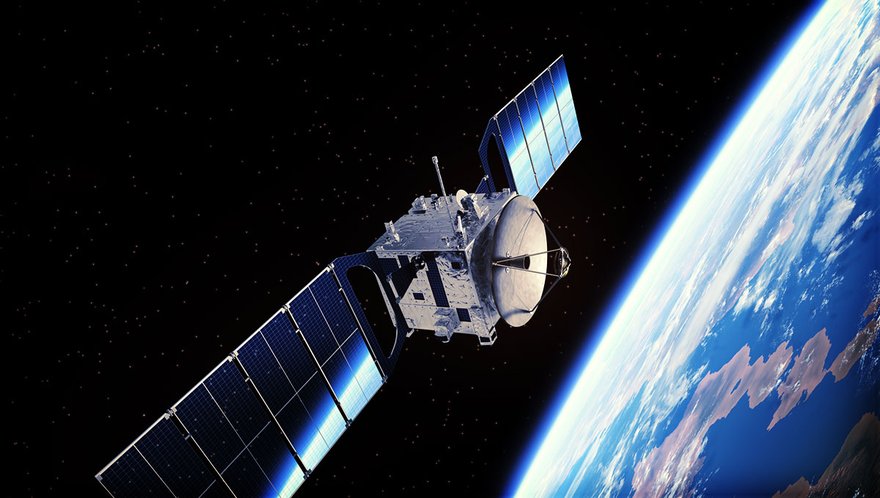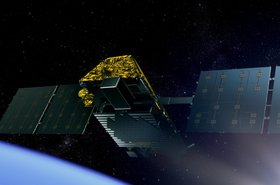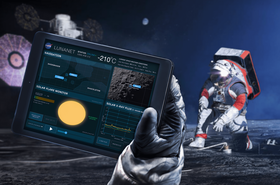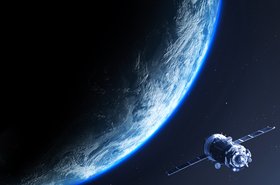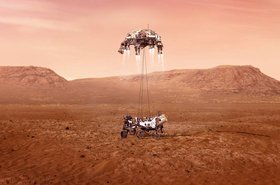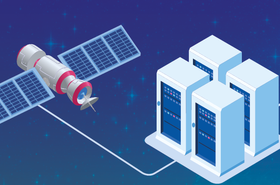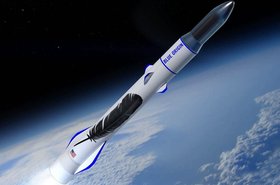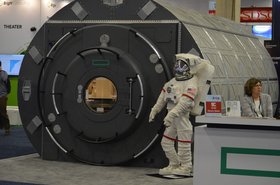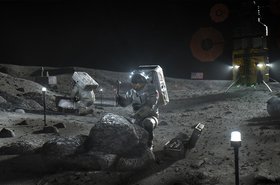The space above Earth is getting crowded. Some 8,500 satellites, probes, landers, crewed spacecraft and the like have been launched into Earth orbit or beyond since Sputnik launched in 1957.
More than 3,000 satellites are currently in operation in orbit. But that number is set to explode. More than 1,000 satellites have been launched in the last year alone, the majority (more than 900) coming from commercial players. It’s becoming common to see 100 satellites launched from a single rocket.
Within a decade, with tens - if not hundreds - of thousands of satellites in orbit, we will see an increase in space debris the risk of collisions. Massive fleets of satellites will need to constantly maneuver to avoid not only one another but also potentially damaging space debris.
That can’t be handled manually on the ground. The satellite industry needs more automation, and greater oversight to collision avoidance instructions.
The growth of space junk
There are thousands of satellites in operation, but there are thousands more defunct satellites, spacecraft and rocket parts, as well as pieces of debris, scrap, and other flotsam and jetsam circling the planet.
In 1978, Nasa scientist Donald Kessler predicted a scenario where the space around Earth is so full of satellites and debris that it becomes unmanageable and collisions begin to cascade, causing a chain reaction which would render many orbits out of use for generations. Kessler syndrome is not yet a fact, but the current situation presents a major risk for satellite operators.
Around 28,200 pieces of space junk and debris are being tracked in orbit, but the European Space Agency (ESA) estimates the actual number is much higher; warning there could be up to 34,000 objects greater than 10cm, 900,000 objects between 1-10cm, and 128 million smaller than 1cm. The total weight of the debris is estimated to be around 5,000 tons.
The North American Aerospace Defense Command (NORAD) tracks debris, but only objects larger than 10 cm in diameter. Objects between 1cm and 10cm are known as lethal non-trackable debris (LNT), meaning there could be thousands of invisible pieces of debris that could hit a satellite at any time.
Dr. Holger Krag, Head of the Space Safety Programme Office for the European Space Agency says there should be more efforts made to pool debris information, and also glean more accurate information.
“I think we can do more globally to join forces to see even more objects. In an ideal world, you can see everything down to one centimeter,” he explains. “And not only see it, but see it with an accuracy that allows you to travel safely. Because the smaller the objects are, the more inaccurate the information is normally, and you are getting many alarms as an operator.”
Krag says the ESA is looking at using lasers for debris detection, which could improve the accuracy of debris tracking and measurement. Startups such as LeoLabs are beginning to deploy ground-based phased-array radars. LeoLabs claims it is capable of tracking debris as small as 2cm.
The threat of new debris
While rare, collisions in space do happen, and the results can be catastrophic for the equipment - or potentially people - involved in the accident. Collision will also affect every nearby operator. In February 2009 the Russian military satellite Kosmos-2251 collided with the Iridium 33 communications satellite [also known as a ‘conjunction event’]. Traveling at speeds of 26,000 miles per hour, the two satellites were destroyed, creating a cloud of 1,800 large pieces of space debris, each capable of destroying any spacecraft they hit. Much of the debris remains in orbit today.
Since the Iridium-Kosmos incident, operators have monitoring of space debris more closely, and shared potential collision information better - and a number of near-misses have been logged.
In April 2021, the EU Space Surveillance and Tracking (EU SST) initiative warned of a possible collision. A defunct US meteorological satellite and a rocket body launched in 1971 by the former Soviet Union to deliver a satellite into orbit came within 21 meters of each other, narrowly avoiding a major collision. In 2020 a Soviet Parus navigation satellite launched in 1989 narrowly missed a Chinese rocket booster launched in 2009.
Even the smallest debris can disable operational spacecraft. A fleck of paint was enough to damage a window on the International Space Station (ISS). While the ISS has some shielding to protect it against larger pieces, this isn’t practical or possible for the majority of satellites, requiring them to instead make numerous collision avoidance maneuvers.
The ISS has made such avoidance measures 28 times since 1999, including three times in 2020. The moves use fuel, and the ISS has a regular stream of resupply missions. For satellites with finite fuel supplies, regular avoidance measures aren’t sustainable long term.
There are various efforts to try and remove space junk and debris from orbit; Astroscale’s Elsa-d satellite, the world’s first commercial mission to demonstrate a space debris removal system, launched in March. But the best way to keep space junk to a minimum is to create as little as possible through proper traffic management and proper satellite disposal.
Subscribe to DCD'S free magazine here for regular features on space, satellites, and the Edge
LEO sat surge add complexity
Where once the space above Earth was a relatively quiet country road, today there is a proverbial superhighway of satellites in orbit.
The space above Earth is roughly divided into three strata: Low Earth Orbit, which is anything an altitude below 2,000 km (1,200 miles); Middle Earth Orbit between 2,000 km (1,243 mi) and 35,786 km (22,236 miles); and Geostationary Earth Orbit (GEO) at 35,786 kilometers (22,236 miles).
Spacing in GEO is tightly controlled; the UN-backed ITU issues a finite number of slots to countries, which then divide them up for military, science, and commercial use. Though very high up, the GEO orbital plane on which satellites stay in sync with the Earth is very narrow, meaning there is little room for error when it comes to collisions or debris.
In LEO, however, there is very little control. Companies are only limited by what their governments will grant them permission for - and governments across the world are authorizing huge amounts of new satellites. There are dozens of startups planning varying numbers of satellite constellations – ranging from small, box-sized CubeSats to fridge-sized machines weighing hundreds of kilos – that could see tens of thousands of satellites launched over the next decade.
SpaceX’s Starlink has launched over 1,000 satellites in the last few years to provide high-speed broadband internet connectivity and has permission from the FCC to launch more than 40,000 into LEO. Amazon’s Project Kuiper will see the company invest $10 billion to launch over 3,000 satellites this decade. Though it has scaled back plans since emerging from bankruptcy, the UK’s OneWeb still plans to have almost 650 satellites in orbit by June 2022.
A number of Chinese companies are also planning to launch thousands of satellites; Xie Tao, founder of Beijing Commsat Technology Development Co., Ltd, told China Money Network he expects the country to launch 30,000 to 40,000 Satellites in the future, compared to 40,000 to 60,000 launched by the US.
Even large incumbents need to act in the face of new competitors, with Telesat planning to launch almost 300 satellites weighing 700 kilos each by 2023 for its Lightspeed broadband constellation.
Governments can issue a near-unlimited number of satellite licenses, but a lack of global coordination at a time of rapid proliferation means the skies are becoming increasingly busy.
“I think there need to be changes for it to be sustainable,” explains astrophysicist Jonathan McDowell of the Harvard-Smithsonian Center for Astrophysics. “I think that there needs to be some at least US and hopefully international agreement on what is the carrying capacity of low Earth orbit. Because there's no upper limit, there's no statement that we won't launch more than 200,000 satellites into the lower layer."
McDowell says the current launching tens of thousands of satellites might be a ‘landgrab’ to secure as many satellites as possible before regulations change and impose limits.
“I think at some point we're going to have to say that you can only have X number of satellites for this altitude band or something like that, and allocate orbital slots in a comparable way to how we allocate orbital slots in GEO.”
Close calls in space becoming more common
Though there is more room for flexibility around positioning at LEO, the number of new satellites being introduced there is creating potential headaches both in terms of space traffic management.
Though large satellites in GEO are robust and, by definition, stationary, even they aren’t capable of withstanding any major impact with large debris or another satellite. LEO sats, which are much smaller and traveling at much faster relative speeds, have almost no chance of surviving an impact with even small pieces of debris, let alone another satellite.
In 2019, the European Space Agency's (ESA) Aeolus satellite raised its orbit in order to pass safely over Starlink 44, one of just the first 60 SpaceX satellites launched. The Agency said at the time that was its first-ever collision avoidance manoeuver, but Krag says the ESA's fleet of satellites receives "hundreds" of warnings a day, though most are for debris rather than other satellites.
“And we do avoidance maneuvers every two weeks roughly," he says. "That's normal business today.”
Nasa recently signed an agreement with Starlink to create increased interaction and partnership between the two companies to “ensure continued safe on-orbit operations” and ensure avoidance of ‘conjunctions’ between the two entities’ satellites and rockets. The agreement will see Nasa provide detailed mission info so Starlink can ensure its automated avoidance measures are up to date, while also working with SpaceX on improving its ability to assess and avoid potential incidents.
February saw a Galileo constellation satellite perform a manoeuver in orbit to avoid an Ariane 4 upper stage launched in 1989. The satellite was taken out of service while it made the manoeuver, and returned to service after nearly three weeks. It was the first time one of Europe’s global navigation satellite systems (GNSS) was required to make such a measure.
In April of this year, SpaceX and OneWeb satellites had a near miss, coming as close as 190 feet of one another.
While large satellites are routinely equipped with propulsion systems, it's only recently that smaller sats in LEO have begun to have their own propulsion – Starlink sats reportedly have ion drive propulsion – meaning many are incapable of making any kind of effort to avoid space debris or other satellites in close orbits. The result can be a regular stream of near misses and minor adjustments for the satellites that can move.
In a report filed to the FCC, Amazon explained that if one in 10 of its Kuiper satellites were to fail while in orbit, there would be a 12 percent chance one of them would collide with a piece of space debris. At a failure rate of one in 20 satellites, there would be a six percent chance of a collision. While six percent is high in the conservative realm of space, Kuiper is yet to launch any satellites into space, and could improve to a very low failure rate in a short space of time. SpaceX went from a 13 percent failure rate with its V0.9 prototypes, to a 3 percent failure rate with its first V1 sats, to just 0.2 percent after that.
READ MORE OF DCD'S SPACE COVERAGE HERE
Space traffic management needs an update
As the number of players in space increases, the way we manage satellites in orbit needs to change. Tracking potential collisions, notifying impacted parties, and coordinating how they respond is still a largely manual process done over email. Something that is not sustainable as the number of satellites grows.
While there is a relatively robust system for tracking potential conjunction incidents, there is no central body with the ability or authority to tell the parties involved how to act. As well as debris tracking, NORAD also issues collision avoidance guidance for satellites that come close to each other. But the current setup means NORAD merely informs operators of the current trajectories and odds of a collision and leaves coordination of manoeuvrers up to the operators themselves.
“Right now there's a lot of dependence on the US military for these conjunction alerts,” says McDowell. “The 18th Space Control Squadron can see satellite A and satellite B might come close, and it goes to them and says ‘your sats are about to have a close pass you might want to do something about that.' But what they can't do is what an air traffic controller would do, which is to say, ‘satellite A go up one kilometer satellite B go down one kilometer.’”
“That level of space traffic control may be something we need in the long run. But that does require an international agency to do that because of the intrinsically global international nature of low Earth orbit.”
During the SpaceX-OneWeb near miss, the US Space force issued several “red alerts” which then saw OneWeb engineers emailing SpaceX’s Starlink team to coordinate manoeuvrers. SpaceX then reportedly disabled its automated AI-powered collision avoidance system to allow OneWeb to steer its satellite out of the way. SpaceX later disagreed with OneWeb’s view of the event, but the need for automation and greater oversight is clear.
The United Nations Office for Outer Space Affairs (UNOOSA) aims to promote global cooperation in space, but has little power to issue instructions or enforce standards on satellite operators. A 2018 White House directive reportedly sought to make the Commerce Department the “traffic cop” of space. Others believe the Federal Aviation Administration (FAA), which already regulates launches and reentries or the Federal Communications Commission (FCC) – which regulates satellite transmissions and implemented new rules to mitigate orbital space debris in April 2020 – would be best placed to manage space traffic. But while the US is the biggest player and highly influential in the realm of space, many countries would likely be unhappy to take instruction from a US body.
“It's a big debate at this moment how this is going to be organized because there's no international law supporting that,” says ESA’s Krag.
As well as more oversight into detecting and coordinating avoidance, the way companies actually manage satellite avoidance measures of their fleets also needs an update. While SpaceX claims it has automated collision avoidance, it is the exception. Almost all satellite conjunction avoidance measures are handled manually from the ground, issuing individual instructions to individual satellites.
This was because previously there was no need to develop such automated systems, explains Kevin Bell, VP Space Program Operations, Aerospace Corp. Developing automated systems for a handful of satellites making a few avoidance measures a year wasn’t worth the investment. However, with the influx of new LEO sats, handling avoidance measures manually no longer makes sense.
“If we get even a third of the constellations that had been filed for on-orbit, there's just no way you're going to have a person in a loop doing collision avoidance. You need to have an automated system,” says Bell.
McDowell points out the complicating factor that in such large constellations, one collision avoidance measure could easily set off a chain reaction as thousands of satellites try to move out of each others’ way.- an automated version of the Kessler Syndrome.
“If you're doing a collision avoidance maneuver, the problem is not how do I dodge this satellite. The problem is when I've dodged this satellite, am I sure that I haven't moved into the path of another satellite?
“If you have 10 satellites maneuvering at once, you've got to know where they're going to maneuver and not maneuver into their path. It's one of these n-squared problems where it gets much less tractable very quickly, as the number of maneuvering satellites at any one time goes up.”
While there are many complicated challenges to overcome, the good news is it’s not too late to ensure the space above Earth remains sustainable for use, as long as operators act responsibly and Governments can come together and agree to greater oversight.
“I do believe it's possible to have a sustainable high level of activity in low Earth orbit,” says McDowell. “It's possible if you regulate it, if you are careful.”
“You can, with appropriate cooperation or regulation, you could have maybe several times as much activity as we do now if you're really careful about it. You can't have 100 times as much activity and you can't do it in an unregulated environment.”

